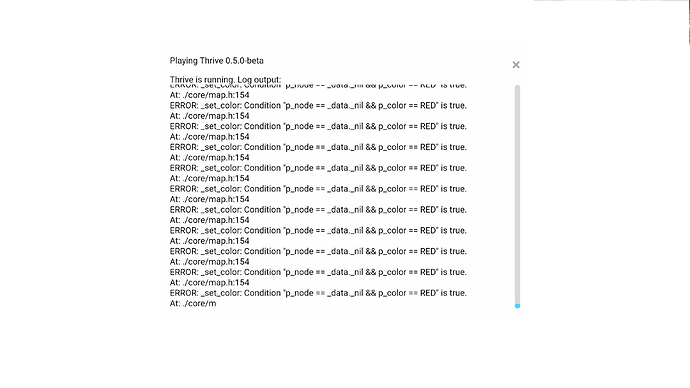See:
99% of all species that have ever existed are in fact extinct.
I agree though, and the patches were designed so that different strategies are best in them. EG in the vents sulfide is best, while in the cave iron is best and so on. I think the patch differentiation is broken in the beta.
I havent been involved for several months now though.
This version is really good. The game was practically unplayable because of the lag in previous versions, but now it’s running smoothly.
Issues:
- I could see some lines separating the background.
- Options isn’t present in the pause menu.
- Died because of ATP loss even with thylakoids in a patch with hight sunlight.
- That flagella model.

The most interesting part is where that error starts happening. That’s just an error happening inside Godot, which I can’t do anything with.
Oh, obvious!  Sorry I’m a noob at this
Sorry I’m a noob at this  . I could start learning things like programming, I feel I need it…
. I could start learning things like programming, I feel I need it…
Oh, Im lucky! i still have the error report
But its buggy for some reason and when I try to go up it goes back and vice versa, and when it works it just shows the same. I’m very sorry
I guess its forbidden 
I’ve been investigating the ATP balance calculation being off, and have noticed that the behavior is stranger than simply having the wrong numbers for organelles. Using the below cell design in the Pangonian tidepool patch,
-
Adding a single additional tile of cytoplasm, photosynthesizing proteins, nitrogenase or an oxytoxysome increases the displayed ATP production to 140.0. Additional tiles increase it by 10 each (instead of 5).
-
Adding a single additional tile of rusticyanin increases the displayed ATP production to 350.0. Additional tiles increase it by 25 each (instead of 20).
What it looks like is happening is that, for calculating the ATP, each type of organelle’s process is multiplied by the total number of organelles, instead of the number of the number of organelles of that type. Namely, 140.0 = number of tiles times 10, which is 5 for the existing thylakoid, and 5 for the new organelle. And 350.0 = number of tiles times 25, which is 5 for the existing thylakoid, and 20 for the new rusticyanin.
Could the species names be with the specific epithet(second part of the name) be not capitalized and maybe the entire species name be written in italic for 0.5.0? I think it’s important to follow the rules of binomial names. Ex: ̶P̶r̶i̶m̶u̶m̶ ̶T̶h̶r̶i̶v̶i̶u̶m̶ Primum thrivium
̶H̶o̶m̶o̶ ̶S̶a̶p̶i̶e̶n̶s̶ Homo sapiens
(I’m not sure but i think the text can be bold, too.)
And ̶b̶a̶t̶h̶y̶p̶al̶a̶g̶i̶c̶ Bathypelagic, too, it was in the beta version.
Some things I’ve noticed:
-
The depth of every patch (below their names) is still displayed as “200-340m below sea level” in the patch map in the editor. I’ve looked through the code and I don’t think this actually refers to any gameplay properties of the patches; it’s just a hardcoded string.
-
The estuary has 78% nitrogen, instead of 70% nitrogen like the rest of Pangonia, so its atmospheric concentration adds up to 108%.
-
Whenever your cell respawns, several large compound clouds usually appear right next to it. This means that after dying there’s often enough ammonia and phosphate already on the screen to reproduce, which seems odd. (github issue)
I had already suggested something based on that, if I am not mistaken about removing these full clouds and about making the clouds in general more dissolved here:
And other problem: about when you take more phosphates and ammonia than you need to reproduce(they start fill their compund bars), and you reproduce, when you exit the editor, the game appears to ‘use’ these excess compounds to fill your bar again, which makes you be able to reproduce again just after exiting the editor.
Some more bugs that I’ve noticed:
-
The “speed” displayed in the editor isn’t the speed of your cell - it’s some weird number based only on the membrane properties and the percentage of organelles which are flagella, so if you just add lots of non-flagella parts to your cell you can get a hulking behemoth that the editor claims is just as fast as the default cytoplasm hex. Also, the speed of a cell that’s only a flagella is shown as “infinity”, even though it’s merely finite.
-
This cell here, a candlestick of cytoplasm 45 hexes long and one hex wide, just completely fails to render its membrane when I play as it. If I give it some organelles, they just seem to float freely in midair.
Similar designs of length 20 render fine (or, at least as fine as any other large cell), similar designs of length 30 have a small patch of membrane surrounding the middle ~half.
I think this might be related to the fact that the initial membrane square size is hardcoded and when the organelles are actually way past that limit, the code for wrapping the membrane points around them fails.
Btw you’ve done a few PRs now, so if you want you can apply and be accepted based on that to be a developer.


